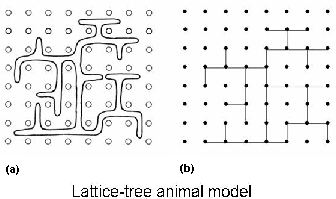Molecular Rheology
Miao Hu
Ben Xu
Jian Wang
Changping Sui
Study of the Viscoelastic Properties of Ring Melts
According to reptation theory, polymer rings can not reptate because there are no "heads" to follow. Knowledge of the dynamic behavior of cyclic macromolecules will enhance the understanding of the fundamentals of polymer dynamics. Linear viscoelastic properties of a series of high molecular weight cyclic polyoctenamers are being studied from both dynamic and static points of view. Both the linear and cyclic polyoctenamers are synthesized in the R.H.Grubbs group at the California Institute of Technology.

Reptation model
Cyclic polyoctenamers have a higher entanglement density than those rings synthesized before. The obtained plateau modulus of cyclic polyoctenamer and linear polyoctenamer are 0.75 × 106 Pa and 1.15 × 106 Pa respectively, which is consistent with that the reported less entangled rings have a plateau modulus less than their linear counter parts. Further work is ongoing to assure macrocyclic purity from linear contaminant and to characterize the nonlinear rheology of the macrocyclic.
Funding
- Department of Energy Grant Basic Energy Sciences, Materials Chemistry Program
Study of Viscoelastic Properties of Cyclic Polyethylene
According to reptation theory, polymer rings can not reptate because there are no "heads" to follow. Knowledge of the dynamic behavior of cyclic macromolecules will enhance the understanding of the fundamental of polymer dynamics. Linear viscoelastic properties of a series of high molecular weight cyclic polyethylenes are being studied from both dynamic and static points of view. The rings have been synthesized by R. H. Grubbs of the California Institute of Technology.

Reptation model
The results show that the activation energy and zero-shear rate viscosity of PE rings are higher than those of linear polyethylene. The obtained plateau modulus of cyclic PE is 2 × 106 Pa, which is within the range of the reported plateau modulus of linear PE. It was found that the linear viscoelastic properties of the cyclic PE are similar to those that have been found on the long chain branched PE, which indicates that the relaxation of the rings is greatly suppressed by certain kinds of topological constraints; interpenetration of loops is considered the main cause of this.

*After M. Rubinstein
Funding
- Texas Higher Education Coordinating Board
- John R.Bradford Endowment at TTU
- Department of Energy Grant
- Basic Energy Sciences, Materials Chemistry Program
Investigation of Nonlinear Viscoelastic Properties of Branched Polyethylene
Double-step strain histories, especially reversing flows, have provided severe tests of nonlinear constitutive equations for the viscoelastic response of narrow dispersed linear polymers in the past three decades. Recently, the reversing double-step strain histories have attracted interest for testing of the nonlinear response of branched polymers.
| Deformation Type | Strain | Strain History | Descriptions |
| Type B | γ2=γ1/2 | |
A half-step strain history |
| Type C | γ2=0 | A step back to zero | |
| Type D | γ2=−γ1 |  |
A fully reversing strain history |
The strain histories of type B, C and D flows
In the present study, single and three types (type B, C and D) of reversing double-step torsional experiments were performed on both commercial branched and linear polyethylenes (PEs); the torque and normal force responses were analyzed within the framework of the K-BKZ theory. Even though the Pom-Pom model developed for the ideal H-molecules was originally expected to perform well for branched polymers, we found that the K-BKZ theory provides better predictions than do Pom-Pom models for the response of branched polyethylene in the reversing double-step strain flows.
Funding
- Texas Higher Education Coordinating Board
- Petroleum Research Fund
Model Network Structure
Background
We are interested in the nanostructure of polymer networks and its influence on material properties. For these investigations we are looking at thermoporosimetry, swelling, and mechanical response of model PDMS networks. The prior showed problems with the Flory-Huggins and Gibbs-Thomson relationships for melting in crystals confined in crosslinked polymers.1, 2, 3 We are furthering these studies by looking into other characteristics of the networks from swelling and mechanical property measurements.
Network Effects on the Swelling of Polydimethylsiloxane Model Networks in Isopiestic Conditions
Here, we use the concepts based on the swelling activity parameter S 4 where the swelling under constant vapor pressure is determined by mass uptake measurements. Assuming volume additivity, we can then calculate the degree of swelling or the isotropic stretch λs. We vary network structure by using end-linked networks and bimodal networks.
Mechanical behavior of Polydimethylsiloxane Networks
We use torsional measurements to determine the elastic response of our model networks to estimate the network characteristics. In the measurements both torque and normal force are used to determine the strain energy density function of the PDMS samples. For the PDMS rubber networks. Taking the so-determined strain energy density function and using classical rubber theory, we are able to estimate the network mesh size or molecular weight between crosslinks. We also compare experimental results with the junction constraint model of Flory and Erman.4
References
Rivlin, R. S. and Sanders, D. W. Phil. Trans. Roy. Spc. London, 1951,243,251
Flory, P. J. 'Principles of Polymer Chemistry', Cornell University Press, Ithaca,
New York(1953).
McKenna, G. B.; Flynn, K. M.; Chen, Y. H. Macromolecules 1989, 22, 4507
Erman, B. Wagner, W. and Flory, P.J. Macromolecules 1980, 13, 1554
Funding
- John R. Bradford Endowment at Texas Tech University.
Instrumentation
- RMS 7200
Polymers and Condensed Matter Physics Group
-
Address
P.O. Box 43121, Lubbock, TX 79409−3121 -
Phone
806.742.3553 -
Email
che@ttu.edu
